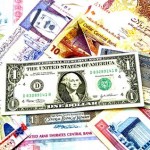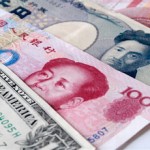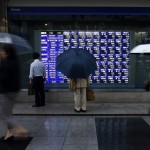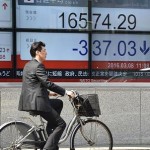Aussie Tumbles as Jobless Surge Revives Rate-Cut Bets; Yen Falls

Australia’s dollar fell by the most in a month as traders revived bets on central bank interest-rate cuts after the unemployment rate jumped to the highest level since 2002.
The Aussie weakened at least 0.5 percent versus all of its 31 major counterparts as Australia’s jobless rate surpassed the U.S. level for the first time since 2007. China’s yuan advanced to the strongest level since March before a report tomorrow that analysts say will show exports rose for a fourth month. The yen weakened against most major peers. The euro was little changed before the European Central Bank announces its monthly policy decision today.
“We’ve seen a big move lower in the Aussie,” said Divya Devesh, an analyst at Standard Chartered Plc in Singapore. “The overall print is not very inspiring, frankly, and this just goes on to show some of the structural problems in the economy,” he said of the Australian jobs data.
Australia’s dollar slid 0.9 percent to 92.70 U.S. cents as of 6:45 a.m. in London, the biggest decline since July 3. It earlier touched 92.63 cents, the lowest since June 5. Levels around 94 to 95 cents for the Aussie are “good selling points” in the next year, Standard Chartered’s Devesh said.
The yen declined as Reuters reported the Japanese Government Pension Investment Fund will boost its holdings of local stocks to more than 20 percent from 12 percent, citing sources it did not identify.
Yen Negative
“Dollar-yen and the Nikkei still trade with a reasonably positive correlation,” said Ray Attrill, the global co-head of currency strategy at National Australia Bank Ltd. in Sydney. “The GPIF changes also imply a big increase in allocation to overseas stocks and bonds, which will be directly yen negative, assuming that at least part of the increase to overseas markets goes unhedged.”
The euro traded at $1.3387 after sliding to $1.3333 yesterday, the weakest level since Nov. 8. The yen fell 0.3 percent to 102.36 per dollar after strengthening yesterday by as much as 0.8 percent. Japan’s currency dropped 0.3 percent to 137.02 per euro.
Traders boosted to 36 percent the odds that the RBA will cut its benchmark interest-rate by a quarter-percentage point by year-end, compared with a 16 percent probability yesterday, according to 30-day interbank futures. The central bank has kept its key rate at 2.5 percent since August 2013.
Aussie Jobs
Australia’s jobless rate jumped to 6.4 percent last month from 6 percent in June, the statistics bureau said. The number of people employed fell by 300, compared with the forecast for an increase of 13,200 in a Bloomberg News survey.
The Aussie has still strengthened 5.5 percent this year, the best performer of 10 developed-nation currencies tracked by Bloomberg Correlation-Weighted Indexes. The U.S. dollar gained 1 percent, while the euro tumbled 1.9 percent.
The euro was 0.4 percent from a nine-month low reached yesterday before the ECB’s decision. Economists surveyed by Bloomberg predict officials will keep the euro-area refinancing rate at 0.15 percent. They also forecast the ECB will maintain its negative deposit rate.
ECB President Mario Draghi will hold a press conference after the rates decision.
The euro “downtrend seems to be pretty well ingrained” given Draghi is unlikely to be hawkish or insensitive to data weakness in the common-currency region, said Kymberly Martin, a market strategist in Wellington at Bank of New Zealand Ltd.
Yuan Strength
The yuan strengthened for a fourth day as economists predict tomorrow’s government report will show exports climbed 7 percent from a year earlier in July, compared with 7.2 percent in June. The trade balance will be in surplus for the fifth month, another survey showed. The yuan yesterday rose beyond the central bank’s fixing for the first time since its trading band was doubled to 2 percent on March 17.
“The convergence of the yuan spot and fixing is significant as it shows reduced People’s Bank of China intervention along with improved sentiment over economic fundamentals,” said Banny Lam, co-head of research at Agricultural Bank of China International Securities Ltd. in Hong Kong. “We continue to see portfolio inflows into Chinese assets, which is supportive of the yuan.”
China’s currency climbed 0.1 percent to 6.16 per dollar after appreciating to 6.1561, the strongest since March 17, China Foreign Exchange Trade System prices show.
Source: Bloomberg





























